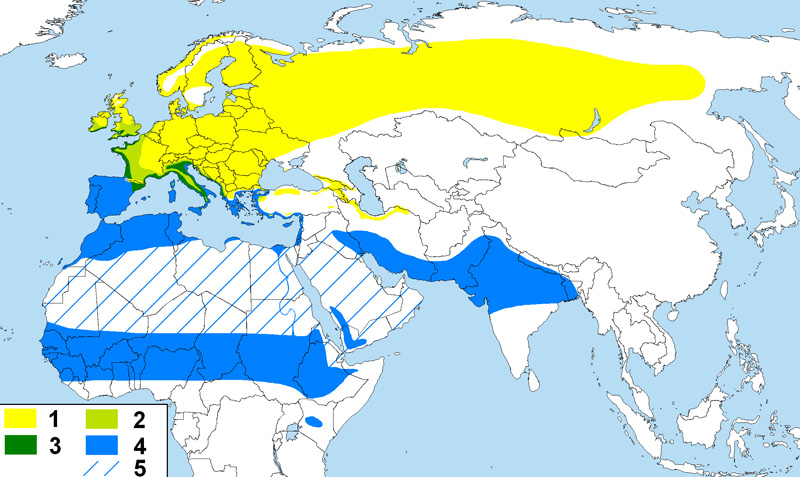
Súlyok és méretek
| Hossz | 10-tól 12-ig cm |
|---|---|
| Súly | 6-tól 8-ig g |
Állatleírás
The Common Chiffchaff, scientifically known as Phylloscopus collybita, is a small, dainty bird that is a widespread and well-known warbler across Europe and parts of Asia. It belongs to the family Phylloscopidae, which encompasses a variety of leaf-warblers known for their distinctive songs and insectivorous diets. The Common Chiffchaff is particularly celebrated for its simple yet melodious song from which it gets its onomatopoeic name, often described as a repetitive "chiff-chaff, chiff-chaff" sound that heralds the arrival of spring.Physically, the Common Chiffchaff is a diminutive bird, measuring approximately 10 to 12 centimeters in length and weighing between 7 to 9 grams. It exhibits an olive-brown coloration on its upper parts, with more muted and paler hues on its underparts, providing it with excellent camouflage against the foliage in which it prefers to dwell. The bird is characterized by its dark legs, a notable feature distinguishing it from some of its closely related counterparts. Its beak is thin and pointed, an adaptation for its insectivorous diet, allowing it to adeptly pick small insects and larvae from leaves and twigs.
The Common Chiffchaff is a migratory bird, with populations breeding across Europe and the western parts of Asia during the warmer months before migrating to the warmer climates of southern Europe, Africa, and South Asia to overwinter. This migration is a testament to the bird's remarkable endurance and navigational abilities, despite its small size.
Breeding habits of the Common Chiffchaff involve the construction of a domed nest on the ground, often in dense vegetation, where the female lays and incubates a clutch of eggs typically numbering between 4 to 7. Both parents partake in feeding the hatchlings, which are altricial at birth, meaning they are born in a relatively undeveloped state and require considerable parental care.
In terms of behavior, the Common Chiffchaff is an active and agile bird, often seen flitting about in the canopy in search of food. Its diet primarily consists of insects and other small invertebrates. The bird's agility and small size enable it to navigate through leaves and branches with ease, making it a fascinating species to observe for birdwatchers.
Conservation-wise, the Common Chiffchaff is currently listed as of Least Concern by the International Union for Conservation of Nature (IUCN), indicating that, for now, it faces no immediate threat of extinction. This status can be attributed to its wide range, adaptability to different habitats, and the general abundance of its population across its range. However, like many bird species, it remains vulnerable to habitat destruction, pollution, and the broader impacts of climate change, which could affect its migratory patterns and breeding success.
In summary, the Common Chiffchaff is a small yet resilient bird, admired for its distinct song and migratory prowess. It plays a vital role in ecosystems as a control agent for insect populations, and its presence is a marker of the changing seasons, making it an integral part of the natural world.
Előfordulási térkép

Hasonló állatok
Új állatfotók
Top 10 állat
- Dolphin gull (Leucophaeus scoresbii)
- Diana monkey (Cercopithecus diana)
- Moustached guenon (Cercopithecus cephus)
- Galápagos tortoise (Geochelone nigra complex)
- Japanese macaque (Macaca fuscata)
- Russian tortoise (Testudo horsfieldii)
- Stone loach (Barbatula barbatula)
- Greek tortoise (Testudo graeca)
- Common flying dragon (Draco volans)
- Vendace (Coregonus albula)


